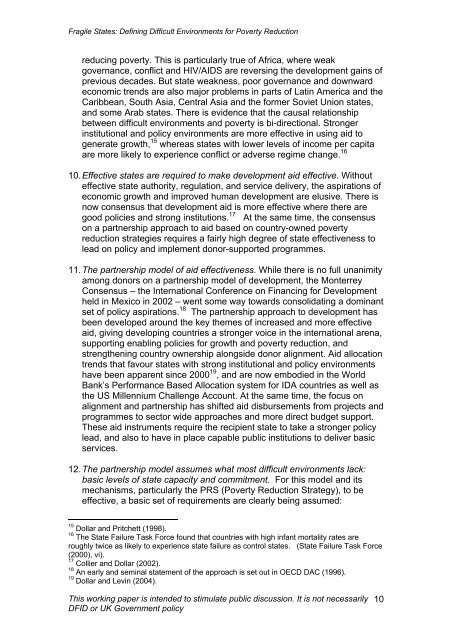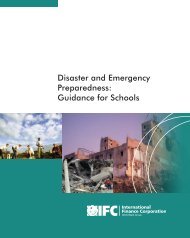Fragile States: Defining Difficult Environments for Poverty ... - INEE
Fragile States: Defining Difficult Environments for Poverty ... - INEE
Fragile States: Defining Difficult Environments for Poverty ... - INEE
Create successful ePaper yourself
Turn your PDF publications into a flip-book with our unique Google optimized e-Paper software.
<strong>Fragile</strong> <strong>States</strong>: <strong>Defining</strong> <strong>Difficult</strong> <strong>Environments</strong> <strong>for</strong> <strong>Poverty</strong> Reductionreducing poverty. This is particularly true of Africa, where weakgovernance, conflict and HIV/AIDS are reversing the development gains ofprevious decades. But state weakness, poor governance and downwardeconomic trends are also major problems in parts of Latin America and theCaribbean, South Asia, Central Asia and the <strong>for</strong>mer Soviet Union states,and some Arab states. There is evidence that the causal relationshipbetween difficult environments and poverty is bi-directional. Strongerinstitutional and policy environments are more effective in using aid togenerate growth, 15 whereas states with lower levels of income per capitaare more likely to experience conflict or adverse regime change. 1610. Effective states are required to make development aid effective. Withouteffective state authority, regulation, and service delivery, the aspirations ofeconomic growth and improved human development are elusive. There isnow consensus that development aid is more effective where there aregood policies and strong institutions. 17 At the same time, the consensuson a partnership approach to aid based on country-owned povertyreduction strategies requires a fairly high degree of state effectiveness tolead on policy and implement donor-supported programmes.11. The partnership model of aid effectiveness. While there is no full unanimityamong donors on a partnership model of development, the MonterreyConsensus – the International Conference on Financing <strong>for</strong> Developmentheld in Mexico in 2002 – went some way towards consolidating a dominantset of policy aspirations. 18 The partnership approach to development hasbeen developed around the key themes of increased and more effectiveaid, giving developing countries a stronger voice in the international arena,supporting enabling policies <strong>for</strong> growth and poverty reduction, andstrengthening country ownership alongside donor alignment. Aid allocationtrends that favour states with strong institutional and policy environmentshave been apparent since 2000 19 , and are now embodied in the WorldBank’s Per<strong>for</strong>mance Based Allocation system <strong>for</strong> IDA countries as well asthe US Millennium Challenge Account. At the same time, the focus onalignment and partnership has shifted aid disbursements from projects andprogrammes to sector wide approaches and more direct budget support.These aid instruments require the recipient state to take a stronger policylead, and also to have in place capable public institutions to deliver basicservices.12. The partnership model assumes what most difficult environments lack:basic levels of state capacity and commitment. For this model and itsmechanisms, particularly the PRS (<strong>Poverty</strong> Reduction Strategy), to beeffective, a basic set of requirements are clearly being assumed:15 Dollar and Pritchett (1998).16 The State Failure Task Force found that countries with high infant mortality rates areroughly twice as likely to experience state failure as control states. (State Failure Task Force(2000), vi).17 Collier and Dollar (2002).18 An early and seminal statement of the approach is set out in OECD DAC (1996).19 Dollar and Levin (2004).This working paper is intended to stimulate public discussion. It is not necessarilyDFID or UK Government policy10
















